Canon Rangefinder 50mm Lenses
A Description of Canon Rangefinder 50mm Lenses produced 1947-1970

the excellent Canon 50mm f1.4 lens on a 1961 Canon 7 rangefinder
The Beginning of Canon Lens Manufacture
As was described in the canonrangefinder.org page description of the Nikkor 50mm lens, Nippon Kōgaku developed the initial lenses for all Canon cameras prior to World War II. At the end of the war, Seiki-Kōgaku (Canon) undertook to manufacture its own lenses for its cameras, beginning with the standard 5cm.
Peter Kitchingman in his excellent book Canon M39 Rangefinder Lenses 1939-1971 2 describes a small number of lenses manufactured by Seiki-Kōgaku (Canon) during World War II for the military and for X-ray cameras and photographic enlargers. Following the war, Seiki-Kōgaku made their first rangefinder camera lenses beginning December, 1945. These lenses used the trademarked name "Serenar".
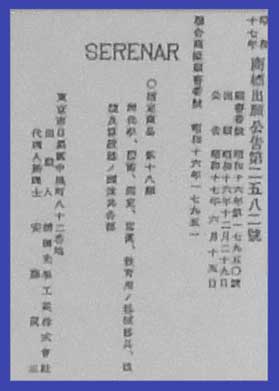
Registration of the 'Serenar' trade name in early 1940s
A small number of 5 cm f3.5 Serenar lenses were manufactured December 1945 to September 1946 - probably less than 200. 2
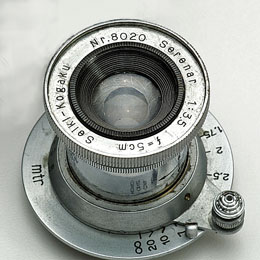
Seiki-Kogaku Serenar 5cm f3.5 of January 1946
perhaps the 9th or 10th Seiki-Kōgaku Serenar 5cm f3.5 produced
The Seiki-Kogaku Serenar 5cm f3.5 was a collapsible lens construction, nearly identical to the lens construction Nippon Kōgaku Kogyo had been providing. This was a Tessar-type lens of 4 elements in 3 groups. The millimeter 50mm focal length notation was not yet in use and "f = 5cm" was the labeling on the front ring of the lens. Canon changed to millimeter labeling in April 1949. 2
With the introduction of the Canon S-II rangefinder, in October 1946, Seiki-Kōgaku manufactured the Serenar 5 cm f3.5 in quantities necessary for this new camera. Nearly 1000 lenses with the Seiki-Kōgaku company name on the lens front were produced.
On 15 September 1947, the company name was changed from Seiki-Kōgaku Kogyo Co. Ltd. to Canon Camera Company Ltd. 2 With this change, Serenar lenses began to show the new company name on the front ring of the lens.
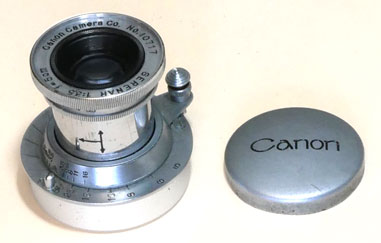
Canon Serenar 5cm f3.5 of 1948
Serenar 5cm f3.5
In February 1947 Seiki-Kōgaku introduced its second 50mm Serenar lens: the Serenar 5cm f3.5. This was a 4 element in 3 groups lens of Tessar design. It did not have front filter threads, and accepted a 36mm slip-on adapter ring for Series VI accessories.
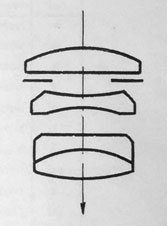
Canon Serenar 5cm f3.5 version 1 design
The construction was similar to the Serenar 5cm f3.5 lens set into a collapsible lens mount. A few of these lenses (206) 2 were with Seiki-Kōgaku labeling, but in September 1947, the company name was change to Canon Camera Company Ltd. Lenses were then labeled "Canon Camera Co." The next approximately 4,000 lens units were manufactured 1947 to 1949 in a slightly different mount and showed the new company name on the front ring of the lens.
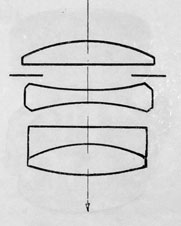
Canon Serenar 5cm f3.5 version 2 design
In April 1949, Canon adopted millimeter descriptions of its lenses and this lens became the Serenar 50mm f3.5 lens. 2
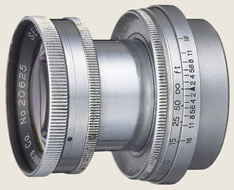
Canon Serenar 5cm f2.0 of 1949 with "Canon Camera Co." on front
Serenar 50mm f1.9
In the page of this canonrangefinder.org site describing the innovative Canon IIB introduced in April 1949, description was made of the new Serenar 50mm f1.9 in a collapsible mount. This was the usual lens sold with the Canon IIB from 1949 to the end of 1951.
With the introduction of this lens, Canon also changed lens focal length designation to mm - Serenar 50mm rather than Serenar 5cm. From 1949 to the end of 1951, the Serenar 50mm f1.9 was the standard lens on not only the Canon IIB, but also the Canon III, Canon IIC, and Canon IV. Kitchingman estimated that about 26,000 if these Serenar 50mm f1.9 lenses were manufactured. 2 This made Canon a significant manufacturer of camera lenses for the first time.
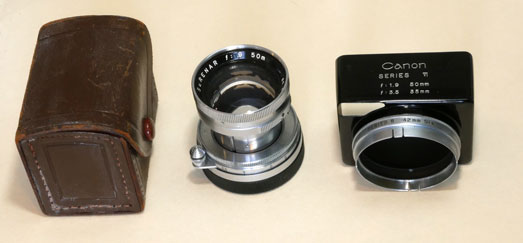
Serenar 50mm f1.9 lens with its special lens hood and well-made leather case for the hood
This lens was a design of 6 elements in 4 groups with a 40mm filter size.
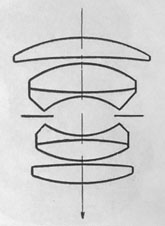
Canon 50mm lenses after change from "Serenar" to "Canon Lens"
In December 1952, Canon decided to change the branding of its lenses from "Serenar" to "Canon Lens". This was at the time of the introduction of the Canon IIIA and Canon IVF. The introduction of these cameras also implemented a change in the Canon lens mount from the so-called "called "semi-universal" mount, which was close but not exactly the same as the standard Leica M39 screw pitch. With the introcution of the Canon IIIA, IVF, and IVS, the lens flange screw pitch was updated to be identical with the Leica screw pitch.
Introduced with these cameras were two new 50mm lenses in solid, non-collapsible lens mounts in a satin chrome finish: the Canon 50mm f1.8 in November 1951 and the Canon 50mm f1.5 introduced in November 1952. The two lenses at first glance are not easy to distinguish one from the other, since their size and finish are similar, although the f1.5 is somewhat shorter and of course had a larger lens diameter.
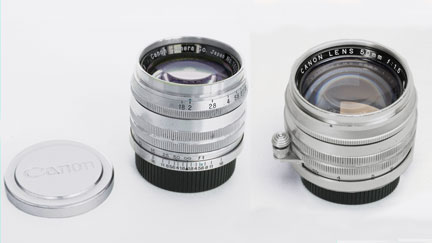
Canon 50mm f1.8 of 1952 (left) and 50mm f1.5 of 1953 (right)
The Canon 50mmm f1.8 was a new Planar-type design of 6 element lens in 4 groups and accepted a 40mm filter. Being a Planar design, it was longer than the Canon 50mmm f1.5 - a Sonnar design.
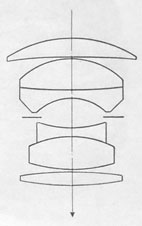
The Canon 50mmm f1.5 was released in November 1952 one year after Canon 50mmm f1.8. It was of an innovative design (although performing less well than the f1.8). It used new rare-earth glasses and was a 7 element 3 group Sonnar-type design. It accepted 40mm filters, just as the Canon 50mmm f1.8 did. Being a Sonnar design, it was shorter than the Canon 50mmm f1.8 - a new Planar-type design, although the f1.5 was of course wider due to the larger aperture. It was single-coated and needed its lens hood attached for best performance.

The Canon 50mmm f1.5 was expensive for its day: 36,500 Yen compared with 26,000 Yen for the f1.8. Nevertheless, the Canon 50mmm f1.5 sold about 17,000 lenses in 1953 to 1956. In April 1956 with the introduction of the Canon VT, Canon introducted a new range of more modern-looking lenses, and production of the Canon 50mmm f1.5 ended. At this time, the The Canon 50mm f1.8 was also redesigned and presented in a new black format, as shown below. Some 90,000 of the solid chrome mount Canon 50mmm f1.8 lenses had been produced prior to this new 50mm f1.8 presentation. In image quality, the Canon 50mmm f1.8 was superior to the f1.5.
Canon 50mm lenses of the mid-1950s
In January 1955, Canon introduced a new 50mm f2.8 lens as a raplacement for the older 50mm f3.5 as the entry level lens for its rangefinders.
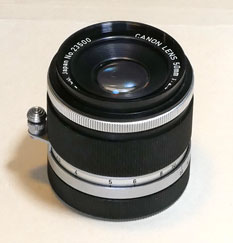
Canon 50mm f2.8 the new style black body of 1958
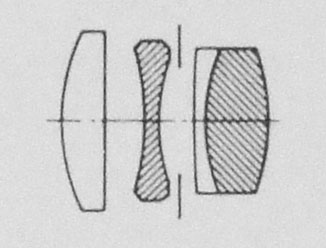
Recall that the older Canon 50mm f3.5 (or "Seiki-Kōgaku Serenar" 5cm f3.5) of 1946 was the first Canon-manufactured lens produced in quantity. The new Canon 50mm f2.8 was of 4 elements in 3 groups. Canon gave this new lens what is often called an 'art deco' look (see photo below), with deep indentations in its dramatic black focusing ring. In the later 1950s, this lens, updated with a smooth black focusing ring (see photo above) was often sold as the economy version with the popular Canon P. This lens in its various versions sold about 26,000 units over four years until the end of 1959. 2
Then in April 1956, Canon introduced the Canon model VT which was a major step forward in the evolution of the Canon series of rangefinder cameras. With this new, more modern look of the Canon VT, Canon revised the Canon 50mm f1.8 in a new lightweight metal alloy and black focusing ring and lens ring. This was an attractive and modern-looking normal lens as well as having good performance. In this new version, the Canon 50mm f1.8 continued in production until 1975, and sold an impressive 144,000 units. 2
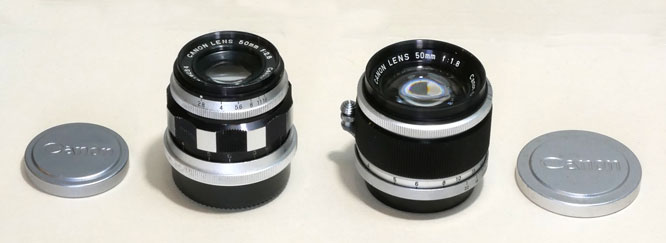
Canon 50mm f2.8 from 1955 (left) and 50mm f1.8 in black from 1956
Canon 50mm f1.2
Canon launched its new 50mm F1.2 in Japan in September 1956. 4 At its launch, it was the fastest 50mm M39 screw mount lens available. It used a new rare earth glass formulation 2 of 7 elements in 5 groups. It was produced in a chrome mount with black focusing ring and a less common all black version (as shown in below). This was of course a very fast lens for 1956 and added to the Canon reputation. It is a 'good but not great' 50mm lens, tending to be somewhat soft when used wide open. However, stopped down to f2.0 it gave sharp images with good contrast.
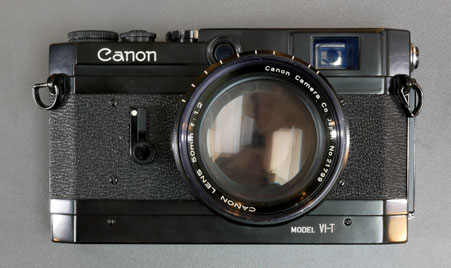
Canon 50mm f1.2 mounted on a black Canon VI-T of 1959
this example is the fairly rare all-black Canon 50mm f1.2
the only Canon lenses they made all-black for black Canon cameras were the Canon 50mm f1.2, the Canon 50mm f1.8, and the Canon 35mm f1.8 2

Canon 50mm f1.4 Lens
Canon launched the new 50mm f1.4 lens in December 1957. 4 This lens, since its inception has grown to be perhaps the best regarded of all the Canon 50mm lenses, and is still used today on a wide range of camera bodies (even the latest digital cameras which can accept M39 mount lenses using inexpensive adaptors).
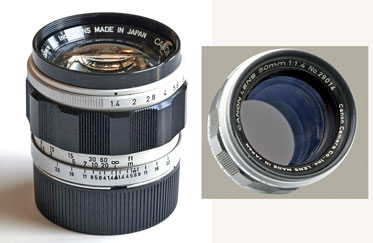
Canon 50mm f1.4
Peter Kitchingman 2 states that initially the Canon 50mm f1.4 lens did not sell particularly well in North America, because Canon promoted the Canon 50mm f1.2 lens with the Canon VI-L, Canon VI-T and Canon P for marketing reasons, as you can see on the black Canon VI-T, above.
The Canon 50mm f1.4 lens was of 6 elements in 4 groups using new high-refraction glass, and accepted a 48mm filter.
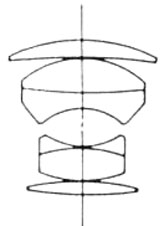
The Famous Canon 50mm f0.95 Lens
In June 1961, Canon launched a massive new 50mm lens, the Canon 50mm f0.95. This was coincident with Canon's launch of the completely new rangefinder, the Canon 7. This lens was designed in 7 elements in 5 groups.
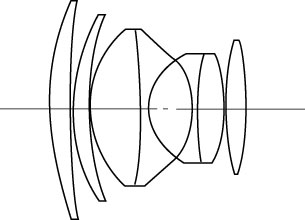
Weighing 600 grams (1 1/3 pounds) and with a large body to accomodate the very large elements, this lens required a new mount flange added to the newly launched Canon 7 rangefinder, and later in the Canon 7s amd Canon 7sZ cameras.
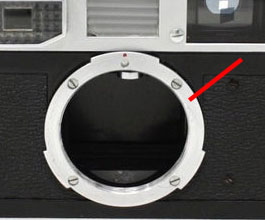
There was a new locking bracket at the rear of the lens to allow it to enguage the new mount flange
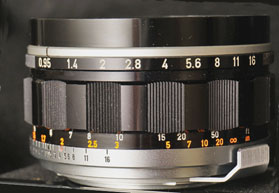
This lens had an immediate impact due to its speed, massive size, and the striking concept of a camera lens having a speed faster than f1.0. It was of course the fastest lens of its day, and was also adapted to other uses such as with television cameras and in cinematography. The lens continued in production until the end of 1970 and sold nearly 20,000 units. With the end of Canon 50mm f0.95 rangefinder lens production, Canon from 1970-1984 continued to manufacture a version for TV cameras and cinematography which had no rangefinder coupling. Of these, and impressive 7,000 units were produced.
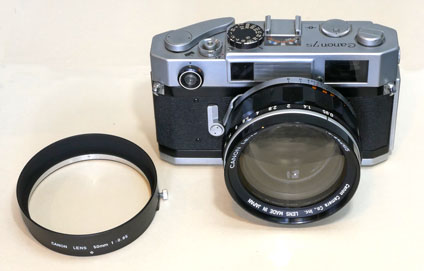
Canon 50mm f0.95 on a Canon 7s of 1966
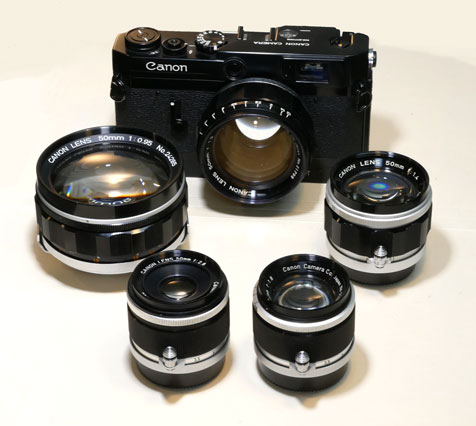
Canon 50mm lenses: f1.2 on black Canon VI-T, f0.95, f1.4, f2.8, f1.8
So, as can be seen from the 50mm lens history above, in a short 15 years, Canon progressed from its earliest tentative manufacture of small quantities of lenses whose design was based in the earlier designs of Nippon Kōgaku Kogyo (Nikon) to become itself one of the world's leaders in camera lens design and production in both quantity and technology.
M. Wilkinson and C. Glanfield published privately a paper entitled A Lens Collector's vade mecum. 19 This included a number of interesting areas of information about Canon lenses. Regarding 50mm lenses, they included a photograph of all the Canon lenses used on Canon rangefinder cameras 1945 to 1968, shown below
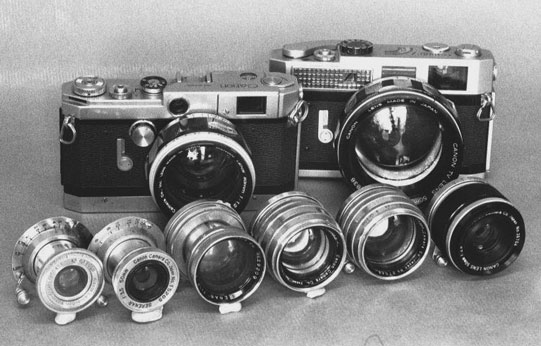
back left: Canon 50mm f1.2 on a Canon VT, back right: Canon 50mm f0.95 on Canon 7
front, left to right: Nikkor 50mm f4.5, Serenar 50mm f3.5, Serenar 50mm f1.9, Canon 50mm f1.8, Canon 50mm f1.5, Canon 50mm f2.8
You can click on the links in the table below to consult other pages of the canonrangfinder.org site.
| Navigation: Click Below to Jump to Desired Subject Page | ||
|---|---|---|
| Canon Rangefinder Cameras - 1 | Canon Rangefinder Cameras - 2 | Canon Rangefinder Lenses |
| Canon Hansa | Canon IIAF, IIAX | Development Nikkor 50mm |
| Canon S | Canon IVSB2 | Canon 19mm |
| Canon J | Canon IIS2, IID2, IIF2 | Canon 25mm |
| Canon NS | Canon VT, Canon L2 | Canon 28mm |
| Canon JS | Canon L1, L3 | Canon 35mm |
| Canon S-I | Canon VT Deluxe | Canon 50mm |
| Canon J-II | Canon VL, VL2 | Canon 85mm |
| Canon S-II | Canon VI-L, VI-T | Canon 100mm |
| Canon IIB | Canon P | Canon 135mm |
| Canon III, IIC, IV | Canon 7 | Canon 200mm-1000mm |
| Canon IIIA, IVF, IVS | Canon 7s | Canon Accessories |
| Canon IIA, IID, IID1 | Nicca Rangefinders | Canon Finders |
| Canon IVSB | Minolta Rangefinders | Minolta Lenses |
| Canon IIF, IIS | Other Rangefinders | other M39 lenses |
| Go to canonrangefinder.com home page | ||
Any additions or corrections to these pages would be welcome simply by contacting this site as shown at the foot of this page .
Footnotes:
1 Dechert, Peter. Canon Rangefinder Cameras 1933-1968. Hove Collectors Books. West Sussex, United Kingdom. 1985. ISBN 0-906447-30-5.
Peter Dechert's book is the most important expert source of information regarding Canon Rangefinder Cameras.
2 Kitchingman, Peter. Canon M39 Rangefinder Lenses 1939-1971. A Collector's Guide. Published by Peter Kitchingman. Perth, Australia. 2008. ISBN 978-0-646-48144-9.
Peter Kitchingman's book is the definitive study of the more than three decades of M39 format camera lenses developed for Canon Rangefinder Cameras.
3 Nostalgic Canon Camera Book. 懐かしいキヤノン EI Publishing Co. Ltd. Tokyo, Japan. June 2003.
Peter Kitchingman's book is the definitive study of the more than three decades of M39 format camera lenses developed for Canon Rangefinder Cameras.
4 "Canon Camera Museum" history website. https://global.canon/en/c-museum/history/ published by Canon, Inc. accessed in 2019.
5 Rajner, Hans P. (author), John Wade (editor). Leica Copies. Classic Collections Publications. London, UK. ISBN 13: 9781874485056
Hans P. Rajner's book is an excellently detailed and carefully researched study of camera from around the world which used the Leica M39 lens mount and the same lens to film plane distance.
7 Dechert, Peter. Canon Single Lens Reflex Cameras 1959-1991. Historical Camera Publications. Yakima, Washington. 1992. ISBN 1-879561-04-2.
8 Tomlinson, Shawn M. The Film Photography Book. Lulu Pulbications. 2016. ISBN: 9781365263972
9 Sartorius., Ghester. Identifying Leica Lenses. Classic Camera 19. Tokyo, Japan. 2001. ISBN 4-257-12029-0
10 website http://www.nicovandijk.net/rflensmatrix.htm consulted 2019.
11 O'Reagan, Douglas M. Allied Exploitation of German Science after World War II. Johns Hopkins University Press. Baltimore, Maryland. 2019. ISBN 9781421428888
12 website www.canonrangefinder.servehttp.com consulted 2008.
13 Minolta expert Andrea Aprà has posted information on minoltarangefinders group and other groups and further detailed information by email. (thanks Andrea !)
14 website http://www.collection-appareils.fr/objectifs/ consulted 2019.
15 Small, Marc James. Non-Leitz Leica Thread-Mount Lenses. Wittig Books. Hückelhoven, Germany. 1997. ISBN 3-930359-47-2.
16 the Nikon Corporation website: https://imaging.nikon.com/history/ consulted 2019.
17 p 152. Ray, Sidney F. Photographic Lens ISBN 9780240510323
18 website http://www.rokkorfiles.com/Lens%20History.html accessed 2019
19 Wilkinson, M. and Glanfield, C. A Lens Collector's vade mecum
Draft Paper Edition 1997. revised 2001.
If you have any comments or questions about this Canon Rangefinder site,
please e-mail me (Larry Huffman) at e-mail address:
[email protected]